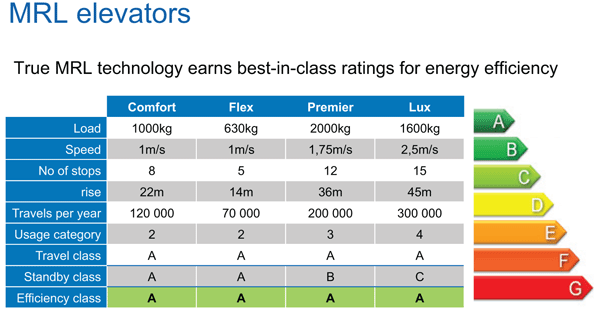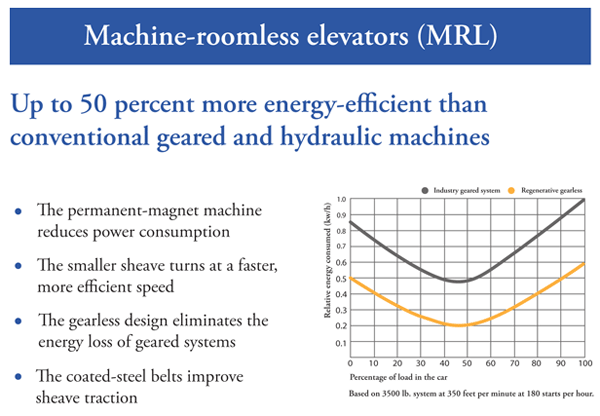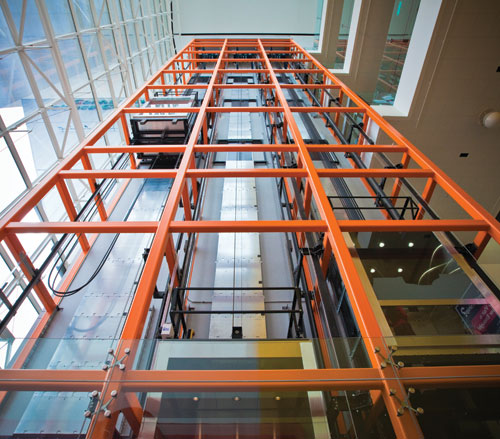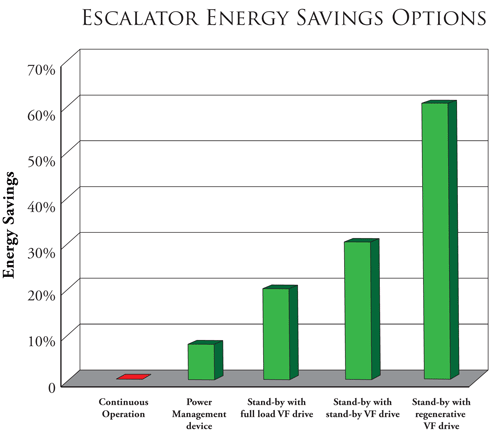Next Generation Machine-Roomless Elevators
The Manufacturer’s Sustainability Quotient
Architects interested in optimizing sustainability of their projects should examine each stage of a product's life cycle. In manufacturing, a key indicator is how well a company recycles industrial waste; some elevator manufacturers claim a recycling rate of 99 percent. Efficiencies during installation — which can include minimizing time required, materials used, packaging recycled — are another key way of gauging a manufacturer's commitment to sustainability. Technologies like remote monitoring allow companies to target maintenance activities so that drive time and gas consumption are reduced. Environmentally sound maintenance practices also extend to safe waste removal and non-toxic cleaners. Frequently, end-of-life practices allow re-use of more than 95 percent of product materials. Coated-steel belts in particular can be successfully recycled. Manufacturers that partner with suppliers tend to have specific recycling programs for those items.
Where MRLs Can Contribute to LEED Points
LEED, or Leadership in Energy and Environmental Design, is an internationally recognized green building certification system. Developed by the U.S. Green Building Council (USGBC) in March 2000, LEED provides architects, building owners, and operators with a framework for identifying and implementing practical and measurable green building design, construction, operations and maintenance solutions.
LEED does not certify specific products — only entire projects can earn LEED accreditation. While elevators and escalators cannot themselves earn LEED points, they can contribute to a project's achievement of LEED points in several areas.
 |
Chart courtesy of Otis Elevator Company |
Innovation and Design Credit 1 — Progressive Design
The purpose of this credit is to provide design teams and projects the opportunity to be awarded points for exceptional performance above the requirements set by the LEED-NC Green Building Rating System and/or innovative performance in Green Building categories not specifically addressed by the LEED-NC Green Building Rating System. Elevators incorporating the latest green MRL technology may be eligible for this credit.
Energy and Atmosphere Credit 1 — Regenerative Drives
According to the U.S. Department of Energy, buildings use 39 percent of the energy and 74 percent of the electricity produced each year in the United States. The Energy and Atmosphere category encourages a wide variety of energy-wise strategies: commissioning; energy use monitoring; efficient design and construction; efficient appliances, systems and lighting; the use of renewable and clean sources of energy, generated on-site or off-site; and other innovative measures. The intent of this credit is to achieve increasing levels of energy performance above the baseline in the prerequisite standard to reduce environmental and economic impacts associated with excessive energy use. Elevators and escalators with regenerative drive systems all increase energy efficiency and may be able to contribute to earning this credit.
 |
Chart courtesy of Otis Elevator Company |
Materials and Resources Credit 7 — Certified Wood in Cab
MR Credit 7 is a contributory credit. The intent is to encourage environmentally responsible forest management. If wood is selected as part of the elevator cab interior, installing Forest Stewardship Council- (FSC) certified wood could help to gain credit. A minimum of 50 percent (based on cost) of wood-based materials and products must be certified in accordance with the Forest Stewardship Council's principles and criteria.
Indoor Environmental Credit 4 — Paints, Sealants, Adhesives
The U.S. Environmental Protection Agency estimates that Americans spend about 90 percent of their day indoors, where the air quality can be significantly worse than outside. The Indoor Environmental Quality category promotes strategies that improve indoor air as well as those that provide access to natural daylight and views and improve acoustics. Vertical transportation systems may contribute to this credit by applying non-toxic paints, sealants, and adhesives in controlled factory environments.
 |
Elevators can contribute to LEED points. Photo courtesy of Otis Elevator Company |
Smarter, Sustainable Vertical Transportation
The latest technology offers true machine-roomless elevators — products that give architects more design freedom, owners more revenue, and passengers greater comfort. With more compact motors and smaller footprints, next generation elevators generate greater energy savings. These savings can be further enhanced by several features including regenerative drives, coated steel belts, LED lighting and sleep mode functions. True MRLs also generate significant construction savings because they eliminate the need to build bulky machine rooms and control rooms. As architects and owners press for ever greener structures, vertical transportation has an important contribution to make.
 |
Otis Elevator Company is the world’s leading manufacturer, installer and maintainer of elevators, escalators and moving walkways—a constant, reliable name for more than 150 years. www.otis.com |









